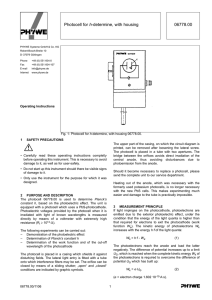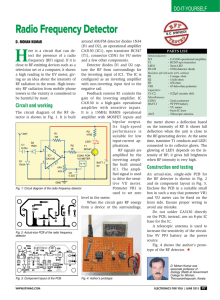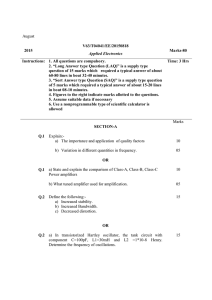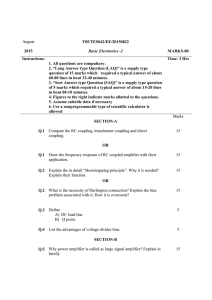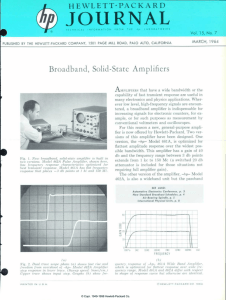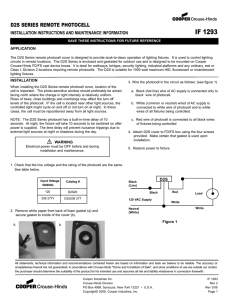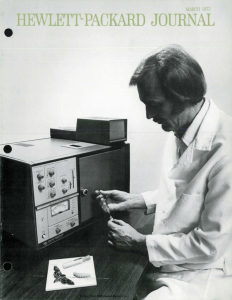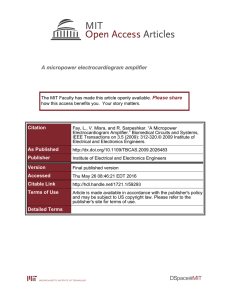XVI. VISUAL REPLACEMENT PROJECTS L. Washington, Jr.
advertisement
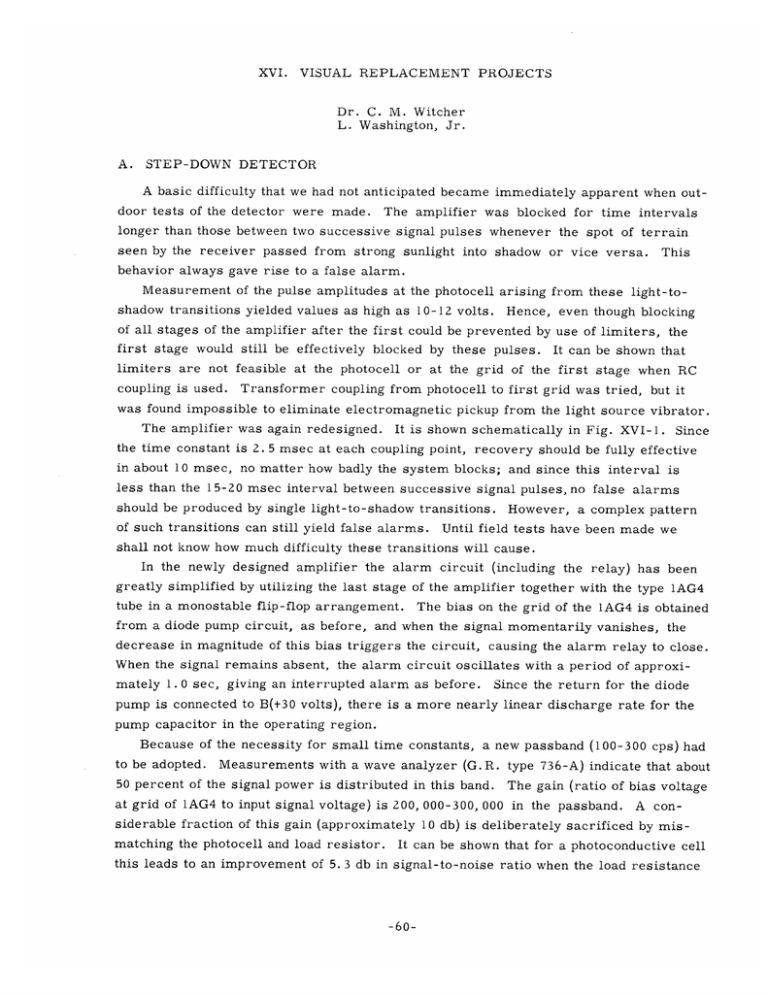
XVI. VISUAL REPLACEMENT PROJECTS Dr. C. M. Witcher L. Washington, Jr. A. STEP-DOWN DETECTOR A basic difficulty that we had not anticipated became immediately apparent when out- door tests of the detector were made. The amplifier was blocked for time intervals longer than those between two successive signal pulses whenever the spot of terrain seen by the receiver passed from strong sunlight into shadow or vice versa. This behavior always gave rise to a false alarm. Measurement of the pulse amplitudes at the photocell arising from these light-toshadow transitions yielded values as high as 10-12 volts. Hence, even though blocking of all stages of the amplifier after the first could be prevented by use of limiters, the first stage would still be effectively blocked by these pulses. It can be shown that limiters are not feasible at the photocell or at the grid of the first stage when RC coupling is used. Transformer coupling from photocell to first grid was tried, but it was found impossible to eliminate electromagnetic pickup from the light source vibrator. The amplifier was again redesigned. It is shown schematically in Fig. XVI-1. Since the time constant is 2. 5 msec at each coupling point, recovery should be fully effective in about 10 msec, no matter how badly the system blocks; and since this interval is less than the 15-20 msec interval between successive signal pulses, no false alarms should be produced by single light-to-shadow transitions. of such transitions can still yield false alarms. However, a complex pattern Until field tests have been made we shall not know how much difficulty these transitions will cause. In the newly designed amplifier the alarm circuit (including the relay) has been greatly simplified by utilizing the last stage of the amplifier together with the type 1AG4 tube in a monostable flip-flop arrangement. The bias on the grid of the 1AG4 is obtained from a diode pump circuit, as before, and when the signal momentarily vanishes, the decrease in magnitude of this bias triggers the circuit, causing the alarm relay to close. When the signal remains absent, the alarm circuit oscillates with a period of approximately 1. 0 sec, giving an interrupted alarm as before. Since the return for the diode pump is connected to B(+30 volts), there is a more nearly linear discharge rate for the pump capacitor in the operating region. Because of the necessity for small time constants, to be adopted. a new passband (100-300 cps) had Measurements with a wave analyzer (G. R. type 736-A) indicate that about 50 percent of the signal power is distributed in this band. The gain (ratio of bias voltage at grid of 1AG4 to input signal voltage) is 200, 000-300, 000 in the passband. A con- siderable fraction of this gain (approximately 10 db) is deliberately sacrificed by mismatching the photocell and load resistor. It can be shown that for a photoconductive cell this leads to an improvement of 5. 3 db in signal-to-noise ratio when the load resistance -60- (12K) PBS PHOTO-CEl OV) ~. nl Int ..* -11 I rnnlnrnl~Lv~ -IN" __Fig. 3. 4. -- SELENIUM DIODES XVa6 GA I 30 *1 WATT METALIZED Fig. XVI-1 Step-down detector electronics. (XVI. VISUAL REPLACEMENT PROJECTS) is 10 times the (average) resistance of the cell. We have been attempting to clarify an apparent anomaly that has been encountered in the signal-to-noise ratio for the present system. The noise developed by each of several PbS photocells has been carefully measured with the wave analyzer mentioned above and a Ballantine decade amplifier (type 220A) at several different frequencies. These measurements were quite reproducible, the (1/f) law very closely. and the noise power was found to follow On the basis of these measurements, the total rms noise voltage produced by the best cells at the input of the amplifier within its passband is calculated to be 5-7 v. This should give a dc output voltage of less than 2.0 volts. The noise arising from all sources other than the photocell is found by direct measurement to give 1. 0 volt. is 5-7 volts. However, the observed value of dc output when the photocell is present This represents a 10-db degradation of signal-to-noise ratio. When the photocell of the step-down detector is operated directly into the Ballantine amplifier and wave analyzer with the latter tuned to the strongest usable signal harmonic, signal-to- noise ratios range from 40-50 db for good scattering surfaces down to 8-10 db for a pool of water with a black dirt bottom. When these data are used to calculate the signal-to- noise ratio which should be expected from the step-down detector's amplifier for the case of the pool with dirt bottom, they give a value of only about 2 db. With the experi- mentally observed degradation in the system, it is obvious that the signal must be completely masked, which is confirmed by observation. (This worst possible condition was not examined until after publication of the Quarterly Progress Report for July 15, 1953.) Actually, a usable signal is obtained with the present system from most kinds of wet surfaces, B. but puddles with dirt bottoms produce false alarms. ACOUSTICAL TRAINING AIDS A few years ago several workers on sensory aids for the blind (1, 2, 3) were of the opinion that a directed beam of high-frequency sound could be successfully used as a means for obstacle detection. More recently, it has been concluded that the predomi- nantly specular character of sound reflections and the masking effects of ambient noise make this scheme unreliable for general use. produce either high-frequency Nevertheless, simple devices which tones (8-12 kc) or a succession of sound pulses with maximum energy in this same region may have real value as training aids to enable the newly blinded to acquire "obstacle sense." This so-called sense, which enables some blind or blindfolded people to detect objects a few feet away, is a composite of several factors, by far the most important of which is the hearing of sounds reflected from the objects. To gain this ability to detect and localize such reflected sounds, training is needed. A few months ago we developed a very simple form of pulse projector. It is shown photographically in Fig. XVI-2; its circuit is shown schematically in Fig. XVI-3. -62- This Fig. XVI-2 Sound pulse projector. MOMENTARY SWITCH 22.5V 22.5V 0.0021L f Fig. XVI-3 Sound pulse projector schematic. -63- (XVI. VISUAL REPLACEMENT PROJECTS) is a simplification of the device described in reference (1). The transducer is a crystal sound cell (type MIC 12-1 A8114) distributed by Cosmocord, Ltd., Enfield, Middlesex, England. This crystal is situated in the focal plane of a small spun-aluminum paraboloid (focal length, 0.25 inch; mouth diameter, 4. 0 inches). The horn is mounted inside a small aluminum box along with the two hearing-aid B-batteries, relay, and other circuit elements. Both a switch and a push button are provided on top of the box for either continuous or momentary operation of the device. Within the semicircular front portion of the box is located a deflecting plate that may be used to deflect part of the sound output of the horn to any desired azimuth angle. The device produces sound pulses with peak energies in the region from 10-12 kc/sec and at a repetition rate of about 16 per second. Very little sound is heard directly from the device when it is held about hip level pointing in a forward direction, but reflections from objects directly ahead and/or to one side or the other can be heard under reasonably good conditions at distances up to 20 feet. An even simpler form of device that we have recently constructed consists of a small Galton whistle placed at the focus of a similar paraboloid and supplied with air by a rubber bulb which also serves as handle for the horn. Somewhat similar devices have been constructed by V. Twersky (4). The whistle is tunable, by means of an adjustment and the sound intensity obtained is such that reflections from large objects 50100 feet away can be heard outdoors. screw, Both of these acoustical training aids are at present undergoing evaluation tests by orientators at the Catholic Guild for the Blind, Boston, Massachusetts. C. M. Witcher, L. Washington, Jr. References 1. C. M. Witcher: A Pulsed Sonic Beam Obstacle Detector for the Blind, Radio News (Radio-electronic engineering edition) 9, 8, Oct., 1947 2. Victor Twersky: 3. 4. Sound Flashlight for the Blind, Electronics 21, 156, Nov., 1948 Arthur DiDea: Detection of Obstacles by Blindfolded Persons, The Biological Review (The College of the City of New York) 9, 9, March, 1947 Victor Twersky: Auxiliary Mechanical Sound Sources for Obstacle Perception by Audition, J. Acoust. Soc. Am. 25, 156, Jan., 1953 -64-

